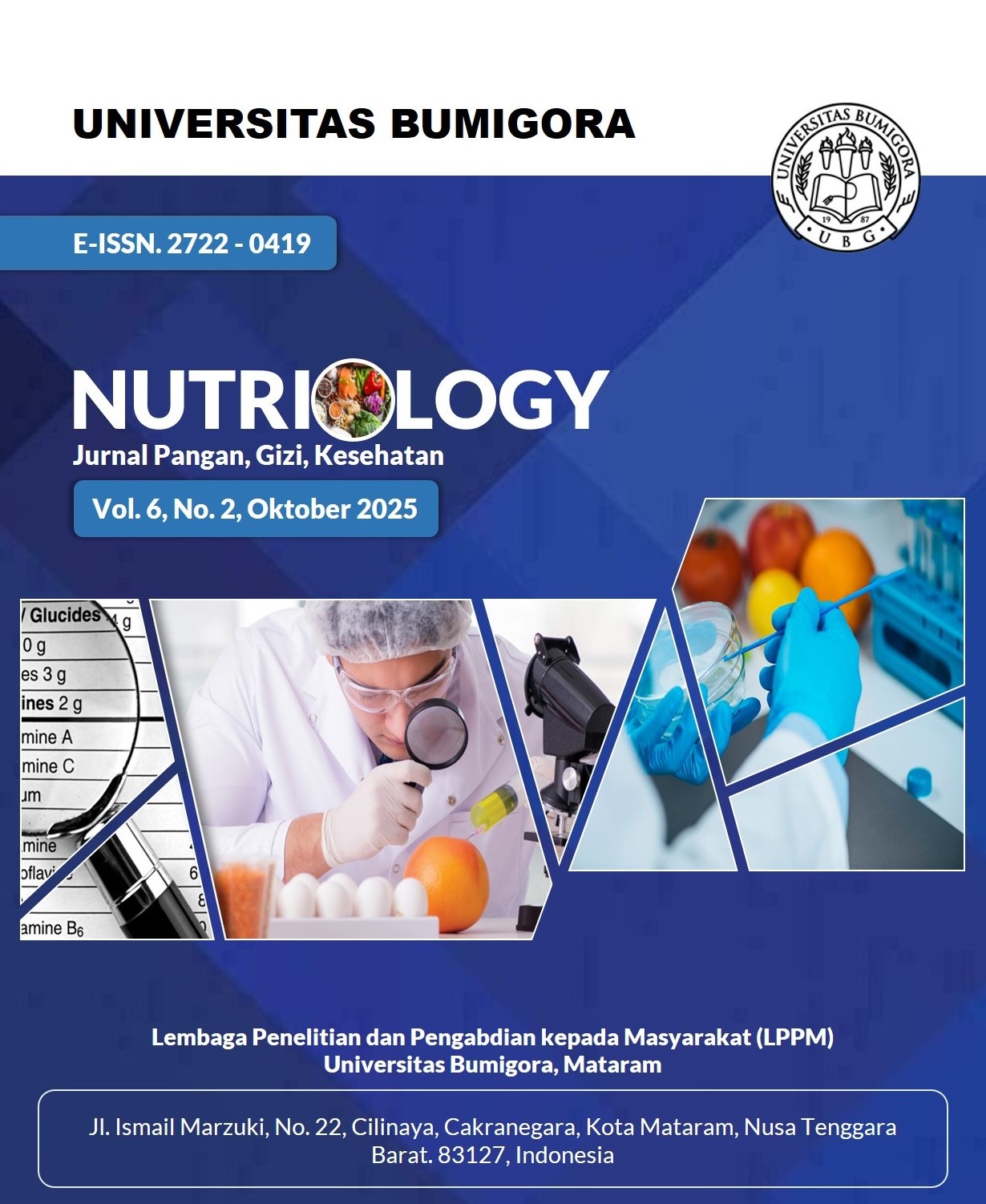Pengaruh Pemberian Sarapan terhadap Konsentrasi Belajar pada Remaja
DOI:
https://doi.org/10.30812/qer20859Kata Kunci:
asupan, konsentrasi belajar, remaja, sarapanAbstrak
Breakfast was a meal at the start of the day that was often overlooked by teenagers, even though it played an
important role in concentration and academic performance. This study aimed to analyze the eect of breakfast
intervention on concentration in adolescents. The research method used a quasi-experimental study design with
secondary data. Data processing was carried out from February to April 2025. The study subjects were divided
into the intervention group (Cibungbulang Junior High School 1) and the control group (Cibungbulang Junior High
School 2), with a purposive sampling technique. The inclusion criteria were that the subjects were in class VII,
had no history of diabetes mellitus, and had complete data on the variables studied, while the exclusion criteria
were incomplete and irrational data.The statistical tests used were the Mann-Whitney dierence and Spearman
correlation tests. The results showed signicant dierences in intake and levels of energy and nutrient adequacy
between the intervention and control groups (p<0.05). The correlation test also showed a signicant relation-
ship between intake and levels of energy and nutrient adequacy with adolescent learning concentration (p<0.05).
Therefore, providing breakfast that met balanced nutritional guidelines was important to improve concentration
and support adolescents' academic performance.
Referensi
[1] Bappenas RI, Rencana Aksi Nasional Pangan dan Gizi 2021-2024. Jakarta: Kementerian PPN, 2021.
[2] M. G. S. Putra, “Hubungan antara Sosial Ekonomi, Demografi dan Kualitas Konsumsi Pangan dengan Status Gizi,” Arter. J. Ilmu Kesehat., vol. 6, no. 1, pp. 31–40, 2024, doi: 10.37148/arteri.v6i1.445.
[3] Kemenkes RI, Gizi dalam Daur Kehidupan. Jakarta: Kementerian Kesehatan RI, 2017.
[4] B. J. Salge, Nutrition and You. Amerika Serikat: Pearson Education Ltd, 2015.
[5] J. E. Brown et al., Nutrition Through The Life Cycl 6 th ed. Amerika Serikat: Cengage Learning, 2017.
[6] I. Yunawati et al., Gizi dalam Daur Kehidupan. Kendari: CV. Eureka Media Aksara, 2023.
[7] Hardinsyah and I. D. N. Supariasa, Ilmu Gizi Teori & Aplikasi. Jakarta: EGC, 2016.
[8] S. K. Putri, “Hubungan Kebiasaan Sarapan Pagi dengan Konsentrasi Belajar pada Anak Sekolah Dasar : Literature Review,” Media Publ. Promosi Kesehat. Indones., vol. 6, no. 8, pp. 1538–1544, 2023, doi: 10.56338/mppki.v6i8.3738.
[9] H. Peña-Jorquera, V. Campos-Núñez, K. P. Sadarangani, G. Ferrari, C. Jorquera-Aguilera, and C. Cristi-Montero, “Breakfast: A crucial meal for adolescents’ cognitive performance according to their nutritional status. the cogni-action project,” Nutrients, vol. 13, no. 4, pp. 1–12, 2021, doi: 10.3390/nu13041320.
[10] X. Ma et al., “Skipping breakfast is associated with overweight and obesity: A systematic review and meta-analysis,” Obes. Res. Clin. Pract., vol. 14, no. 1, pp. 1–12, 2020, doi: 10.1016/j.orcp.2019.12.002.
[11] J. F. López-Gil, P. A. Sánchez-Miguel, M. Á. Tapia-Serrano, and A. García-Hermoso, “Skipping breakfast and excess weight among young people: the moderator role of moderate-to-vigorous physical activity,” Eur. J. Pediatr., vol. 181, no. 8, pp. 3195–3204, 2022, doi: 10.1007/s00431-022-04503-x.
[12] K. Karatzi et al., “Late-night overeating is associated with smaller breakfast, breakfast skipping, and obesity in children: The Healthy Growth Study,” Nutrition, vol. 33, pp. 141–144, 2017, doi: 10.1016/j.nut.2016.05.010.
[13] Kemenkes RI, Riset Kesehatan Dasar 2018. Jakarta: Kementerian Kesehatan RI, 2018.
[14] D. Gede Yenny Apriani, “Hubungan Sarapan Pagi dengan Tingkat Konsentrasi Belajar pada Anak Kelas 4-6 Sekolah Dasar Negeri 1 Tiyinggading,” J. Med. Usada, vol. 5, no. 1, pp. 16–21, 2022, doi: 10.54107/medikausada.v5i1.115.
[15] B. Lentini and A. Margawati, “Hubungan Kebiasaan Sarapan dan Status Hidrasi dengan Konsentrasi Berfikir pada Remaja,” J. Nutr. Coll., vol. 3, no. 4, pp. 631–637, 2014, doi: 10.14710/jnc.v3i4.6862.
[16] A. W. Hazizah, I. S. Embrik, and A. Pratiwi, “Pengaruh Sarapan Pagi terhadap Konsentrasi Belajar pada Anak Kelas V di SDN 04 Tigaraksa,” Gudang J. Ilmu Kesehat., vol. 2, no. 2, pp. 323–328, 2024, doi: 10.59435/gjik.v2i2.864.
[17] R. Marvelia, R. Kartika, and H. Dewi, “Hubungan Sarapan Pagi dengan Prestasi Belajar Siswa di SMA Negeri 4 Kota Jambi Tahun 2020,” Med. Dedication, vol. 4, no. 1, pp. 198–205, 2021, doi: 10.22437/medicaldedication.v4i1.13487.
[18] S. S. Gropper and J. L. Smith, Advanced Nutrition and Human Metabolism Eight Edition. Belmonth: Cengage Learning, 2021.
[19] P. Salsabila and S. Nareswari, “Pengaruh sarapan terhadap konsentrasi belajar,” Medula, vol. 13, no. 1, pp. 146–150, 2023, doi: 10.53089/medula.v13i1.593.
[20] J. Kim and S. Kang, “Relationships between dietary intake and cognitive function in healthy korean children and adolscents,” Lifestyle Med, vol. 7, no. 1, pp. 10–17, 2017, doi: 10.15280/jlm.2017.7.1.10.
[21] R. Irawan, Nutrisi Molekuler dan Fungsi Kognitif. Surabaya: Airlangga University Press, 2020.
[22] R. J. H. West, L. Briggs, M. Perona Fjeldstad, R. R. Ribchester, and S. T. Sweeney, “Sphingolipids regulate neuromuscular synapse structure and function in Drosophila,” J. Comp. Neurol., vol. 526, no. 13, pp. 1995–2009, 2018, doi: 10.1002/cne.24466.
[23] L. Kustiyah, C. Carissa, and F. Anwar, “Relationship between Breakfast Types and Blood Glucose Level and Short-Term Memory of Elementary School Children in Bogor, Indonesia,” in Malaysian Journal of Medicine and Health Sciences, 2020, pp. 27–28.
[24] D. F. Herayeni, R. Hernanda, W. P. Wijayanto, and A. E. Setiawan, “Hubungan Kebiasaan Sarapan Pagi dengan Konsentrasi Belajar pada Anak di SD Mis Sa Al-Husna Purbolinggo,” Heal. Res. J. Indones., vol. 3, no. 1, pp. 20–28, 2024, doi: 10.63004/hrji.v3i1.
[25] J. Jaeger, “Digit Symbol Substitution Test: The Case for Sensitivity Over Specificity in Neuropsychological Testing,” J. Clin. Psychopharmacol., vol. 38, no. 5, pp. 513–519, 2018, doi: 10.1097/JCP.0000000000000941.
[26] E. S. Dasopang et al., Nutrisi dan Dietetika: Prinsip dan Praktik Komprehensif. Solok: Mafy Media Literasi Indonesia, 2024.
[27] Hardinsyah and M. Aries, “Jenis Pangan Sarapan dan Perannya dalam Asupan Gizi Harian,” J. Gizi dan Pangan, vol. 7, no. 2, pp. 89–96, 2012, doi: 10.25182/jgp.2012.7.2.89-96.
[28] M. Z. Ma’arif, A. M. Duwairoh, and A. S. Firdauz, “Hubungan antara Sarapan Pagi dengan Tingkat Konsentrasi Belajar Siswa,” J. Penelit. Sekol. Tinggi Ilmu Kesehat. Nahdlatul Ulama Tuban, vol. 3, no. 1, pp. 52–57, 2021, doi: 10.47710/jp.v3i1.98.
[29] L. Verdiana and L. Muniroh, “Kebiasaan Sarapan Berhubungan dengan Konsentrasi Belajar pada Siswa SDN Sukoharjo I Malang,” Media Gizi Indones., vol. 12, no. 1, pp. 14–20, 2018, doi: 10.20473/mgi.v12i1.14-20.
[30] W. R. Yunita and T. S. Nindya, “Hubungan Kebiasaan Sarapan, Kecukupan Zat Gizi dan Cairan dengan Daya Konsentrasi Anak Sekolah Dasar,” Media Gizi Indones., vol. 12, no. 2, pp. 123–128, 2018, doi: 10.20473/mgi.v12i2.123-128.
[31] C. R. Mahoney, H. A. Taylor, R. B. Kanarek, and P. Samuel, “Effect of breakfast composition on cognitive processes in elementary school children,” Physiol. Behav., vol. 85, no. 5, pp. 81–88, 2005, doi: 10.1016/j.physbeh.2005.06.023.
[32] A. K. Sari and N. Dora, “Konsentrasi Belajar Siswa Ditinjau dari Peran Orang Tua dalam Persiapan Pola Makan dan Kecukupan Gizi,” J. Ilm. Bimbing. Konseling Undiksha, vol. 15, no. 1, pp. 59–66, 2024, doi: 10.23887/jibk.v15i1.80489.
[33] N. Maharani, K. Anwar, and D. H. Maskar, “Hubungan Keberagaman Sarapan, Tingkat Kecukupan Gizi terhadap Daya Ingat Siswa SMAN 12 Kota Tangerang Selatan,” J. Teknol. Pangan dan Kesehat., vol. 6, no. 2, pp. 73–85, 2024, doi: 10.36441/jtepakes.v6i2.2593.
[34] D. E. Anggreny and Meiranti, “Pengaruh Status Gizi Dengan Konsentrasi Belajar Siswa di SD Negeri 2 Sumber Marga Telang,” Heal. Care J. Kesehat., vol. 12, no. 1, pp. 128–134, 2023, doi: 10.36763/healthcare.v12i1.371.
[35] K. Adolphus, C. L. Lawton, C. L. Champ, and L. Dye, “The effects of breakfast and breakfast composition on cognition in children and adolescents: A systematic review,” Adv Nutr, vol. 7, pp. 590S-612S, 2016, doi: 10.3945/an.115.010256.
[36] M. Muchtar, M. Julia, and I. L. Gamayanti, “Sarapan dan jajan berhubungan dengan kemampuan konsentrasi pada remaja,” J. Gizi Klin. Indones., vol. 8, no. 1, pp. 28–35, 2011, doi: 10.22146/ijcn.17728.
[37] T. N. Doloksaribu and M. A.Br.Peranginangin, “Hubungan Kebiasaan Sarapan Pagi dengan Konsentrasi Belajar Siswa Siswi di Sekolah Menengah Pertama,” Nutr. J., vol. 8, no. 2, pp. 317–327, 2024, doi: 10.37771/nj.v8i2.
[38] A. Virginia and T. Sudyasih, “Hubungan kebiasaan sarapan pagi dengan konsentrasi belajar di SMP Muhammadiyah 1 Minggir,” in Prosiding Seminar Nasional Penelitian dan Pengabdian Kepada Masyarakat, Yogyakarta: LPPM Universitas ‘Aisyiyah Yogyakarta, 2024, pp. 215–219.
[39] Z. Tang et al., “The effects of breakfast on short-term cognitive function among Chinese white-collar workers: Protocol for a three-phase crossover study,” BMC Public Health, vol. 17, no. 1, pp. 1–8, 2017, doi: 10.1186/s12889-017-4017-1.
[40] A. S. V. Nababan, M. M. Pinem, Y. Mini, and T. H. Purba, “Faktor yang Memengaruhi Kadar Gula Darah Penderita Diabetes Mellitus (DM) Tipe 2 di RSUD Dr. Djasamen Saragih Pematangsiantar,” J. Dunia Gizi, vol. 3, no. 1, pp. 23–31, 2020, doi: 10.33085/jdg.v3i1.4657.
[41] M. T. Arshad et al., “Role of Dietary Carbohydrates in Cognitive Function: A Review,” Food Sci. Nutr., vol. 13, no. 7, pp. 1–22, 2025, doi: 10.1002/fsn3.70516.
[42] R. A. Daulay, W. Iskandaria, S. Aminah, S. P. R. Tambunan, S. M. Sari, and M. Arya, “Analysis of the Impact of Carbohydrates on Human Health and Disease,” Transpublika Int. Res. Exact Sci., vol. 1, no. 3, pp. 25–31, 2022, doi: 10.55047/tires.v1i3.731.
[43] R. Mafiana and T. Bisri, “Membran Sel Neuron dan Sawar Darah Otak sebagai Struktur Proteksi Otak,” J. Neuroanestesia Indones., vol. 1, no. 3, pp. 209–216, 2012, doi: 10.24244/jni.vol1i3.174.
[44] K. Ramadhani and R. Widyanigrum, Dasar-Dasar Anatomi dan Fisiologi Tubuh Manusia. Yogyakarta: UAD Press, 2022.
[45] A. Johansen et al., “The importance of small polar radiometabolites in molecular neuroimaging: A PET study with [ 11 C]Cimbi-36 labeled in two positions,” J. Cereb. Blood Flow Metab., vol. 38, no. 4, pp. 659–668, 2018, doi: 10.1177/0271678X17746179.
[46] M. Nimgampalle, H. Chakravarthy, and V. Devanathan, “Glucose metabolism in the brain: An update,” Recent Dev. Appl. Microbiol. Biochem., vol. 2, no. 1, pp. 77–88, 2021, doi: 10.1016/B978-0-12-821406-0.00008-4.
[47] M. Rigoulet et al., “Cell energy metabolism: An update,” Biochim. Biophys. Acta - Bioenerg., vol. 1861, no. 11, pp. 1–10, 2020, doi: 10.1016/j.bbabio.2020.148276.
[48] N. S. Chandel, “Glycolysis,” Cold Spring Harb. Perspect. Biol., vol. 13, no. 5, pp. 1–11, 2021, doi: 10.1101/CSHPERSPECT.A040535.
Unduhan
Diterbitkan
Terbitan
Bagian
Lisensi
Hak Cipta (c) 2025 Muh Guntur Sunarjono Putra, Lilik Kustiyah, Cesilia Meti Dwiriani, Eka Septiani

Artikel ini berlisensi Creative Commons Attribution 4.0 International License.










